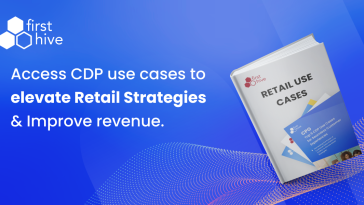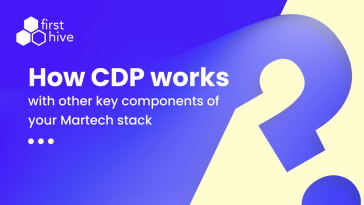Keep guessing. Do you know what exactly runs in your customer’s mind? It is like a young woman stepping into your confectionary store with an intent to purchase a red velvet pastry, but she ends up purchasing a brownie or a basket of mint chocolates. If you were to find out her intent as a store owner, you may not know ‘why?’ she changed her preferences.
This is why marketers rely on data that reveals subliminal information about customers. Data that describe mood, preferences, and sentiments of customers changes at every step of a customer’s journey.
Let’s say you were one of those smart tech-savvy marketers who rely on technology and tools to track every marketing channel. But, yet you lose your customer’s identity when she hops from one channel to another.
With scattered data of millions of customers, you would be keen to know ‘What were the touchpoints that brought them to your store?’, ‘What motivated them to purchase a particular product?’, or ‘Are there other options in your store that you could sell to him/ her?’. Marketing technology augments your efforts to know your customers better, but not in wholesome.
That’s when Customer Data Platform comes to your rescue to stitch the data together and build a unique identity for each customer.
Why should you know as much as possible about your customers?
Businesses are managed by people. And, people stick around with each other based on their relationship. The strength of each relationship is driven by how well you know the other person. This is where local mom-and-pop store owners perform as better marketers than a T-shaped marketing veteran seated in a cabin inside a tall building.
Loyal relationship between your brand and each customer is the answer to better business.
It is more important now than ever to integrate marketing technology with your customer data. Because you need to thrive in an omnichannel environment with ever-increasing channels. And, this is already made a priority by the most successful marketers. Top-performing marketers in North America are 1.6 times more likely to prioritize the integration of marketing and advertising technologies.[1]
Note: Defining terminologies before we dive deeper.
| What is Customer Data? | What is a Marketing Technology Stack? |
| Customer Data includes every little detail about your customer that influences directly or indirectly in the completion of a purchase, all through the customer’s journey across any marketing channel of interaction and information. | Marketing technology stack is a structure that brings together any technological tool, platform, or software that solves the problems of a marketer in deriving customer data or perform different marketing operations before, during, and after a customer journey. |
Google confirms that “Businesses that understand how to interpret potential customers’ intent with contextual information can better identify the right consumers for their products, gaining a competitive edge and increasing sales.”
After auditing technology infrastructure of some of our banking, retail, and real estate customers, FirstHive provided recommendations of marketing stack integration with their customer data. This led to the creation of unique and unified customer identities for all their customers. It also helped in tracing anonymous tertiary data of those influencers who determined the success of a purchase.
Integrating real-time customer data with their marketing technology stack resulted in a 40% to 60% increase in revenues plus an increase in conversion rates at a low cost.

Customer Data & its Impact on Your Business
Business is measured by revenues, touchpoint performance, and other minute metrics that compound to a successful outcome. McKinsey quotes that business performance is a direct determinant of customer satisfaction. The more you create better customer satisfaction, the higher is your ROI, LTV, and so on. Some functions of marketing and product development that use primary, secondary and tertiary customer data to enhance customer satisfaction are as below. The quality of your real-time customer data is what adds more value to these functions.
Behavioral and Personalized marketing
Research tells us that organizations that leverage customer behavioral insights outperform peers by 85 percent in sales growth and more than 25 percent in gross margin.
At FirstHive, we helped a leading salon retail chain in India to gather PII data of its end consumers and build a database of unique customer identities that could be tracked in real-time. Most of their customers engaged on Facebook and the mobile app. The brand used customer behavioral data such as product preferences, salon visits, type of services used, and so on to target and engage customers on different channels.
They also applied the derived intelligence in their customer loyalty program by customizing coupons with a personalized context of salon experience. The brand experienced a significant uplift in Customer Experience as the recommendations to Customers by stylists were now seen as more relevant thereby increasing sales of cosmetics via salon.
Omni-channel experience
The tricky part for marketers is to find out what happens before the customer journey begins and after it ends. Simply stated, the customer’s intent is your problem until they say they do not want to associate with your brand any longer. Apart from the channel mix that you choose, marketers need to watch out for their customers round-the-clock.
An insight by McKinsey that states “Only by looking at the customer’s experience through his or her own eyes—along the entire journey taken—can you really begin to understand how to meaningfully improve performance.”
So, for marketers it is no longer about just planning across multiple online channels of interaction, it includes offline and other dimensions that pan out from family, habits, behavior, social life, new adoptions, and a lot more!
Here is an illustrative representation from McKinsey that we intend to share.

Better product development
It is not just with technology brands, but even otherwise, real-time customer data is a validated and authentic source of ideas for new product development, building road maps, creating personas and other information that become a part of the winning strategy.
For instance, a leading real estate company in India leveraged FirstHive to capture third-party influencer data in real-time that influenced sales of their resident community and commercial projects. This data helped them build newer services and real estate models that were saleable with a perfect product-market fit.
If you are managing more complex diagrams, we know you need more horsepower and a magical crystal ball that predicts the future. The technology adopted by FirstHive’s CDP platform is no less than magic. Instilled with artificial intelligence and machine learning, you can automate cohort segmentation which is a huge pain point during the pre-targeting stage. You receive campaign recommendations, predictive behavior analysis, and channel performance. These capabilities help you optimize how and where would you spend your money!
Connect with us to understand how FirstHive can help you enhance your Customer Experience. Write to us at marketing@firsthive.com or click here to request for demo.









